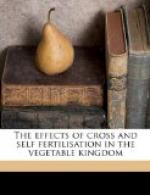SUMMARY OF THE MEASUREMENTS IN TABLE 7/C.
This table includes the heights and often the weights of 292 plants derived from a cross with a fresh stock, and of 305 plants, either of self-fertilised origin, or derived from an intercross between plants of the same stock. These 597 plants belong to thirteen species and twelve genera. The various precautions which were taken to ensure a fair comparison have already been stated. If we now look down the right hand column, in which the mean height, weight, and fertility of the plants derived from a cross with a fresh stock are represented by 100, we shall see by the other figures how wonderfully superior they are both to the self-fertilised and to the intercrossed plants of the same stock. With respect to height and weight, there are only two exceptions to the rule, namely, with Eschscholtzia and Petunia, and the latter is probably no real exception. Nor do these two species offer an exception in regard to fertility, for the plants derived from the cross with a fresh stock were much more fertile than the self-fertilised plants. The difference between the two sets of plants in the table is generally much greater in fertility than in height or weight. On the other hand, with some of the species, as with Nicotiana, there was no difference in fertility between the two sets, although a great difference in height and weight. Considering all the cases in this table, there can be no doubt that plants profit immensely, though in different ways, by a cross with a fresh stock or with a distinct sub-variety. It cannot be maintained that the benefit thus derived is due merely to the plants of the fresh stock being perfectly healthy, whilst those which had been long intercrossed or self-fertilised had become unhealthy; for in most cases there was no appearance of such unhealthiness, and we shall see under Table 7/A that the intercrossed plants of the same stock are generally superior to a certain extent to the self-fertilised,—both lots having been subjected to exactly the same conditions and being equally healthy or unhealthy.
We further learn from Table 7/C, that a cross between plants that have been self-fertilised during several successive generations and kept all the time under nearly uniform conditions, does not benefit the offspring in the least or only in a very slight degree. Mimulus and the descendants of Ipomoea named Hero offer instances of this rule. Again, plants self-fertilised during several generations profit only to a small extent by a cross with intercrossed plants of the same stock (as in the case of Dianthus), in comparison with the effects of a cross by a fresh stock. Plants of the same stock intercrossed during several generations (as with Petunia) were inferior in a marked manner in fertility to those derived from the corresponding self-fertilised plants crossed by a fresh stock. Lastly, certain plants which are regularly intercrossed




